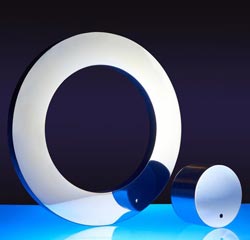Energy- and resource-efficient laser-based functionalizing of temperature-sensitive substrates

Coated bearing and engine components.<br>Picture source: Fraunhofer ILT. Aachen/Volker Lannert<br>
Because conventional coating processes are increasingly coming up against their technological limits and are often too costly, the Fraunhofer Institute for Laser Technology ILT developed a resource-efficient process for laser-based functionalizing of nano- and microparticle materials. As well as being suitable for inline applications, this process is marked by a high degree of flexibility and energy efficiency, while also allowing gentle processing of temperature-sensitive substrates.
Whether it is transparent conductive layers, conductor paths on semiconductors, anti-reflective surfaces on displays, self-cleaning layers on highly transparent glass, or corrosion, scratch and wear protection layers on components subject to high mechanical stress: in almost every area of industrial manufacturing, there is a great need for functional layers to optimize the surface properties of all sorts of components.
Industrially established processes for the production of high-performance coatings tend to employ vacuum coating processes. But these are costly, as they require elaborate systems technology and due to the required batch processing. More affordable processes, such as electroplating or flame spraying, are either applicable only to certain classes of substrate or else display major drawbacks in terms of the layer characteristics they produce. Coating temperature-sensitive substrates is a particularly thorny challenge in this regard.
Energy-efficient coating of temperature-sensitive substrates
Scientists at Fraunhofer ILT, working with industry partners, have succeeded in developing a resource-efficient laser-based surface functionalization process. This process combines wet-chemical coating processes with a laser process for subsequent functionalizing of the applied material. For example, when coating a glass, plastic or semiconductor substrate, an indium tin oxide (ITO)-nanodispersion is printed onto the component using an inkjet process.
Next, a galvo scanner is used to guide a focused laser beam over the surface to be processed. Laser processing significantly increases the conductivity of the ITO layer, while putting the substrate under far less thermal stress and consuming far less energy than conventional furnace-based coating processes. The new laser-based coating process enables the gentle coating of substrates with a low temperature stability and thereby widens the scope of wet-chemical coating processes significantly.
Locally selective deposition saves on material
Using conventional processes to achieve a locally selective coating of surfaces is not possible or prohibitively expensive in most cases. Functional considerations dictate that any surplus material must be subsequently removed, sometimes using elaborate processes, and this results in an enormous cost disadvantage. In contrast, the fact that laser processes can be controlled with spatial and temporal precision means they are able to functionalize coating materials in exactly the right places on the component and with no wastage.
Suitability for inline applications
A further challenge in functionalizing surfaces is how to integrate the coating process into existing production lines. Conventional processes for a thermal post-treatment (e.g. furnace-based processes) cannot be easily integrated into production lines at low costs. Fraunhofer ILT’s laser coating process poses no such problems, since the printing and laser processes it features are ideal for inline applications. This saves manufacturers a huge amount of time and money.
Applications
Fraunhofer ILT’s laser-based coating process can be tailored to meet a wide variety of coating needs. Spatial adaption to the substrate geometry is done by the precise control of the laser intensity distribution. Furthermore the application of pulsed laser beams enables the precise temporal control. Besides creating conductor paths on substrates made of glass, silicon or polymers such as polyethylene terephthalate (PET), it can for instance also be used to apply ceramic corrosion and wear protection layers of zirconium dioxide onto hardened steel. This process is of particular relevance to automotive manufacturing, in which several million components must be coated each year so they can withstand high levels of static and dynamic stress as well as extremes of temperature.
Fraunhofer ILT at Hannover Messe
Our experts will be in Hannover on the joint IVAM booth C50.13 in hall 17 of Hannover Messe from April 8-12, 2013 to present various coated exhibits that highlight the breadth of applications for thin film processing.
Contacts:
Dipl.-Phys. Dominik Hawelka
Group Thin Film Processing
Phone +49 241 8906-676
dominik.hawelka@ilt.fraunhofer.de
Dr. Jochen Stollenwerk
Head of the Group Thin Film Processing
Phone +49 241 8906-411
jochen.stollenwerk@ilt.fraunhofer.de
Fraunhofer Institute for Laser Technology ILT
Steinbachstraße 15
52074 Aachen, Germany
Media Contact
More Information:
http://www.ilt.fraunhofer.deAll latest news from the category: Process Engineering
This special field revolves around processes for modifying material properties (milling, cooling), composition (filtration, distillation) and type (oxidation, hydration).
Valuable information is available on a broad range of technologies including material separation, laser processes, measuring techniques and robot engineering in addition to testing methods and coating and materials analysis processes.
Newest articles

“Nanostitches” enable lighter and tougher composite materials
In research that may lead to next-generation airplanes and spacecraft, MIT engineers used carbon nanotubes to prevent cracking in multilayered composites. To save on fuel and reduce aircraft emissions, engineers…

Trash to treasure
Researchers turn metal waste into catalyst for hydrogen. Scientists have found a way to transform metal waste into a highly efficient catalyst to make hydrogen from water, a discovery that…

Real-time detection of infectious disease viruses
… by searching for molecular fingerprinting. A research team consisting of Professor Kyoung-Duck Park and Taeyoung Moon and Huitae Joo, PhD candidates, from the Department of Physics at Pohang University…





















